Ornithopods are an important branch of the dinosaur family. They consist of some diverse vegetarian dinosaurs and include four families: Dimetrodon, Hypsilodon, Iguanodon and Hadrosaurid. Although all ornithopod dinosaurs are vegetarian, due to their adaptation to different living environments, the shape and function of their teeth are very different. There are great differences between families and even among subordinate genera. It shows the good adaptation of dinosaurs to the ecological environment of the Mesozoic Earth.
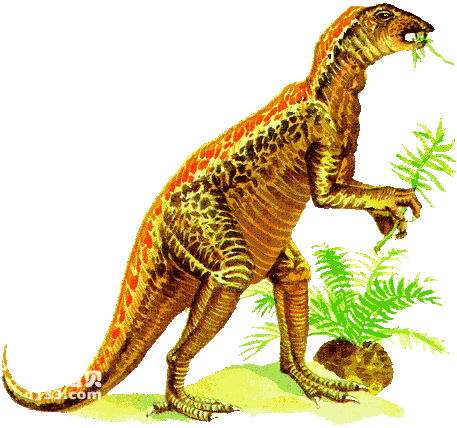
Dimetrodon
1. Dimetrodonidae
Let’s first introduce the Dimetrodontidae. The family includes the following major genera: Lanasaurus, Arboricosaurus, Licohesaurus, and Dimetrodon. Their teeth have the following common characteristics: the cheek teeth have high crowns, which are shaped like chisels, and there are canine-like teeth on the premaxilla and dentary. However, different genera show different degrees of specialization for vegetarianism: the cheek teeth of Arboricus are loosely arranged, the tooth crown is symmetrical, there is an obvious tooth ring, the tooth root is not thickened, and it is obviously different from the tooth crown. Separate; the tooth crowns of Lanasaurus are similar to those of Arboricosaurus, but the tooth crowns are very close to each other, and even some teeth overlap; in Ricohesaurus, the tooth crowns are still symmetrical, but the inner and outer teeth are still symmetrical. The sides have a convex profile, the thicker root has a slight taper, and close to the ring, the length of the crown is proportionally much greater than its width. In Dimetrodon, the tooth root is thick, and its cross-section is somewhat square rather than circular. There is no tooth ring or the tooth root does not shrink. The tooth crown is asymmetrical. The lower tooth crown is straighter on the outside and more convex on the inside. The opposite is true for dental crowns. The convex surface is enameled, while the straighter surface is not, whereas in Aberrenchus and Lanasaurus there is enamel on both sides. Teeth in this family tend to have higher crowns. In Lanasaurus, a pair of inwardly sloping abrasive surfaces along the transverse crests suggests that the movements of the upper and lower jaws were strictly vertical. In other genera, the abrasive surfaces of the teeth usually extend from one tooth to the next.
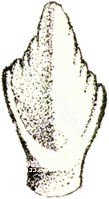
Teeth of Coryocephalosaurus Arbery
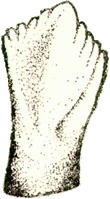
Lanasaurus Teeth

Teeth of Ricoblack Dragon
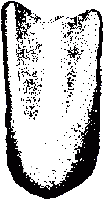
Teeth of Dimetrodon
It is obvious that the Dimetrodontidae were a type of active, agile, vegetarian dinosaurs that walked quickly on two feet and mainly fed on plants on the ground or in the bushes. They first eat plants that are less than 1 meter above the ground. The teeth in the rostral part of the premaxilla are missing, the production of horny edges and the narrowing of the front edge of the premaxilla indicate that it has the ability to relatively select plants. Due to the lack of teeth in the rostral part of the premaxilla, The bones interlocked and the premaxillary teeth created an abrasive surface, suggesting that these teeth were capable of not only piercing bitten food but also cutting it. Their first premaxillary tooth is small, shaped like a nail, and slightly curved; the second one is larger, with a small lingual shelf on the side near the tongue, similar to the first premaxillary tooth; the third premaxillary tooth is canine-shaped. , the edge teeth on both sides have a small range of small serrations. All of these premaxillary teeth are completely covered by a layer of enamel, with a wear surface on the inner surface of the crown, the result of constant occlusion with the upper edge of the predentary bone and its mouth sheath.
The premaxillary dentition lacks canine-like teeth in specimens of Arberycephalosaurus, and it is possible that they represent females or juveniles. The cheek teeth of Arboricosaurus are chisel-shaped, with the denticle-like protrusion located only on the uppermost 1/3 of the tooth crown, and the front and rear edges are clearly separated. Therefore, the distal denticle is connected to the base ring of the tooth. There is evidence of a broad protrusion in the middle of the buccal surface of the crown, but no ridge appears. In the genus Arboricus, the tops of the crowns of each tooth in the maxillary dentition are either symmetrical or slightly pointed backwards. There are 4-7 small teeth pointing toward the top of the crown, and are combined with the basal ring by the front edge.
In Dimetrodon, the tooth crown is high and strong. The large primary rib is located in the center of the buccal surface of the tooth crown. The remaining ribs are slightly weaker than the primary ribs. A single rib develops between the outermost rib and the primary rib. The secondary edge has no ring gear. Extremely worn teeth have been found in Dimetrodon specimens. The angle of the tooth wear surface increases with the age of the animal, ranging from 45 degrees to 65 degrees. In Lanasaurus, the relevant angle can be 75 to 80 degrees.
All these small differences show that dinosaurs of various genera within the family Dimetrodonidae have made careful choices of different niches in their adaptation to the ecological environment. This careful selection shows that dinosaurs were indeed able to make full use of all the niches in the Mesozoic Era. Successful animal taxa in terrestrial niches.
2. Hypsilophodonidae
Hypsilophodontidae are small to medium-sized ornithopod dinosaurs. They walked on two legs and their body structure was not very specialized. They were distributed in Asia, Australia, Europe and North America, and lived from the middle Jurassic to the late Cretaceous. The teeth of Hypsilophodontidae are not all uniform. There are 5 slightly curved simple premaxillary teeth, and 10 or 11 laterally flattened maxillary teeth. The crown of the tooth is widened front and back, and there are small marginal teeth on both sides; There are about 13-14 teeth in their lower jaw. The first 3-4 teeth are relatively simple and cone-shaped. The crowns of other teeth are flat inside and outside, and have marginal denticles like the maxillary teeth. This type of tooth form is called heterodontia.



Hypsilophodon teeth
The buccal enamel of the crowns of the maxillary teeth of Hypsilophodonidae is very strong, with small vertical ridges; most mandibular teeth have thicker lingual enamel, and have obvious middle ridges and several weaker secondary ridges. . The existence of these ribs is probably the origin of the name "Hypsilodon". The wear surfaces of such teeth are flat and inclined, clearly showing strong wear resistance. At the same time, the teeth of Hypsilophodon have double abrasive surfaces, indicating that the movement of its upper and lower jaws was vertical. In addition, Hypsilophodon also has an important characteristic of ordinary ornithopods, that is, the crowns of the upper teeth are curved inward, while the crowns of the lower teeth are curved outwards.
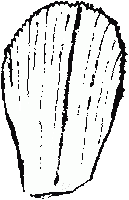

Tenotesaurus Teeth

Dry Dragon Teeth
The genus Tenutosaurus is the largest genus among the Hypsilophodonidae. The crowns of its upper and lower teeth are strong and wide. The buccal surfaces of the upper teeth with enamel have 5-6 ribs of almost equal lengths. The lingual crowns of the lower teeth are The surface is enamel and has a very prominent primary ridge, with small subsidiary ridges developing on both sides of the primary ridge.
The genus Dryosaurus is also a representative of the family Hypsilophodonidae. The buccal surface of the crown of its maxillary teeth has a thick enamel layer and obvious primary ribs, which are usually distributed asymmetrically on the surface of the tooth; there are also 2 more developed on both sides of the primary rib. - 4 secondary edges, the secondary edges point towards and gradually disappear into the small teeth developed at the edge of the crown.
3. Iguanodontidae
Iguanodontidae is one of the most prosperous ornithopod dinosaurs. They are huge, with a length of 5 to 10 meters, and are large dinosaurs. Iguanodontids mainly lived from the late Jurassic to the early Cretaceous, and some species continued into the late Cretaceous. They have specialized five-fingered hands with spear-shaped thumbs, hoof-like claws on the middle three digits, and a very small fifth digit at the end. Such hands are well suited for grasping objects. The family Iguanodontidae includes 6 genera: Camptosaurus, Iguanodon, Dreadnosaurus, Mutabarosaurus, Connerosaurus and Protobarkosaurus, of which Campanosaurus is the most primitive one among them. genus.
The number of teeth in iguanodontids varies in different genera. The number of maxillary teeth can range from 14 to 29. For example, the number of teeth in the genus Camptosaurus is 14, the genus Dreadnosaurus is 22, the genus Barkosaurus is 23, and the genus Iguanodon is 29; the number of teeth in the lower jaw can be from 14 to 29. To 25, for example, the genus Camptosaurus has 16, the genus Dreadnosaurus and Protobarkosaurus both have 23, and the genus Iguanodon has 25. They have no teeth on their premaxillary bones.







Iguanodon teeth
The upper tooth crowns of iguanodontids are narrow, and the buccal and lingual surfaces are rhombus-shaped, relatively longer than the lower teeth. The enamel on the buccal surface of the tooth crown is thickened, with developed marginal denticles, and a dominant tooth. The large primary rib is located behind the midline of the tooth crown; other parts of the tooth crown are relatively smooth except for a few small secondary ribs of different lengths. These teeth have long roots that taper to a point.
poultryThe maxillary teeth of dinosaurs in the dinosaur family were a single row, and the front and rear teeth were smaller than the teeth in the middle. The crowns of these teeth are laterally flattened, and their shapes vary among genera, with some being wider (such as Campylosaurus and Mutabarosaurus), and some being relatively narrow (such as Iguanodon and Protobarkosaurus). The fine structure of the buccal surface (the side with enamel) is also different: some primary ribs are very well developed (such as Campylobacter, Iguanodon, and Protobarkosaurus), and some primary ribs are not developed (such as Mutabarosaurus) genus); some have smooth surfaces without any secondary ribs except for large primary ribs, while others have many secondary ribs (for example, Campylosaurus has 9, Iguanodon has 4 to 6, Muta There are 13 members of the genus Barrowosaurus and 2 to 3 members of the original genus Bacosaurus). In addition, the etching on the front and rear edges is also different.
The crowns of the mandibular teeth of the Iguanodontidae are wider than those of the maxillary teeth, with enamel on the inner surface and varying degrees of ribs. Some primary ribs are developed (such as Iguanodon and Protobarkosaurus), and some primary ribs are not developed (such as Campylobacter); some have more secondary ribs on both sides of the primary rib, and some have small teeth from the edge. The base is extended with three-level ribs. For example, the genus Camptosaurus has about 10 ribs, and the genus Iguanodon has 1 to 2 ribs.
Scientists have also observed the process of tooth replacement in the genus Campylosaurus in such a way that, starting from the tooth behind the even-numbered position, all the teeth located in the odd-numbered position are replaced in sequence. In most cases, the replacement wave goes from back to front, so , the teeth in the replacement dentition become progressively smaller from back to front. Scientists speculate that this tooth replacement process may have been a common phenomenon throughout the iguanodontidae family.
4. Hadrosauridae
The teeth of individual hadrosaurid dinosaurs are very similar to those of iguanodontids, and the tooth crowns tend to be elongated. But the difference is that hadrosaurids had hundreds of teeth on each side of their mandibles. These teeth are held together by bone tissue so that they form a washboard-like cutting surface for chopping up food picked up by the horny beak at the front of the mouth. This structure of the upper and lower teeth can handle harder food, such as fibrous plants or even several branches.






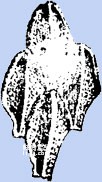
Hadrosaur teeth
A single tooth is composed of dentin and enamel. The surface with enamel is typically diamond-shaped and is divided into two more or less symmetrical front and rear parts by a longitudinal edge. Each tooth differs in the decoration of its edges and enamel surface, some are smooth, and some have tumor-like nodules. On the lingual portion of the mandibular teeth, the exposed enamel surfaces come together to form a checkerboard pattern, with the root of one tooth completely hidden by the crown of the succeeding tooth. On the other hand, in the maxillary tooth row, except for the last tooth in the vertical row, the enamel surface of the remaining teeth is completely covered by most of the previous tooth, and there is no such thing as the lower teeth. Faces in checkerboard format.
The lingual surface of the mandible is very thin and is often broken during fossil preservation, leaving the tooth roots exposed in a plate-like shape. This phenomenon did not occur in the maxilla.
Each row of teeth in hadrosaurid dinosaurs is curved. Unlike vegetarian mammals, the chewing surfaces of the teeth are not perpendicular to the axis of the teeth, but are inclined to the axis of the teeth. Therefore, the chewing surfaces of the upper and lower teeth are closer to vertical than horizontal, so the function of the teeth is to cut, rather than grind like a horse. The curved dentition matches the corresponding dentition characteristics to form an effective feeding machine. In the dentition, the teeth in the middle are larger than those at the ends.
From the structures of the upper and lower jaws and teeth of the Dimetrodontidae, Hypsilodontidae, Iguanodontidae and Hadrosaurids that we have introduced, we can see that from the primitive ornithopod dinosaurs to the advanced ornithopod dinosaurs, from Judging from the shape of the teeth, there is a trend: 1. From the presence of teeth in the premaxilla to the disappearance of the teeth; 2. The number of teeth gradually increases from a small number; 3. The distribution of tooth enamel changes from covering the entire tooth to being distributed on one side ( The upper teeth are on the outer surface, and the lower teeth are on the inner surface); 4. The shape of the crown changes from chisel-shaped to nearly oval to elongated rhombus; 5. The primary edges of the upper teeth change from undeveloped to very developed, and on the surface How many or how few fine edges there are. Such a change trend proves that during the evolution from primitive ornithopod dinosaurs to advanced ornithopod dinosaurs, the function of teeth was gradually strengthened, indicating an aspect of ornithopod dinosaurs' enhanced ability to adapt to the environment.
animal tags:
We created this article in conjunction with AI technology, then made sure it was fact-checked and edited by a Animals Top editor.